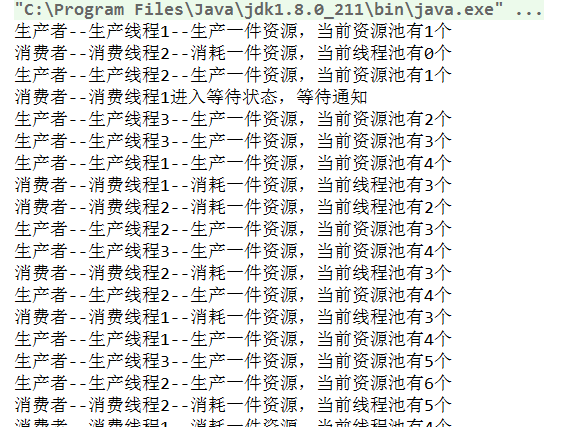There are so many BB S above. It should be understood by taking a producer consumer chestnut as an example:
package com.thr;
/**
* @author Administrator
* @date 2020-04-02
* @desc synchronized+wait+notify Thread communication example (producer consumer model)
*/
public class ProducerConsumerWaitNotify {
public static void main(String[] args) {
Resource resource = new Resource();
//Create 3 producer threads
Thread t1 = new Thread(new Producer(resource),"Production thread 1");
Thread t2 = new Thread(new Producer(resource),"Production thread 2");
Thread t3 = new Thread(new Producer(resource),"Production thread 3");
//Create 2 consumer threads
Thread t4 = new Thread(new Consumer(resource),"Consumption thread 1");
Thread t5 = new Thread(new Consumer(resource),"Consumption thread 2");
//Producer thread start
t1.start();
t2.start();
t3.start();
//Consumer thread start
t4.start();
t5.start();
}
}
/**
* Shared resources (warehouse)
*/
class Resource{
//Current resource quantity
private int num = 0;
//Maximum number of resources
private int size = 10;
//Production resources
public synchronized void add(){
if (num < size){
num++;
System.out.println("producer--" + Thread.currentThread().getName() +
"--Produce a resource. The current resource pool has" + num + "individual");
notifyAll();
}else{
try {
wait();
System.out.println("producer--"+Thread.currentThread().getName()+"Enter the waiting state and wait for notification");
} catch (InterruptedException e) {
e.printStackTrace();
}
}
}
//Consumption resources
public synchronized void remove(){
if (num > 0){
num--;
System.out.println("consumer--" + Thread.currentThread().getName() +
"--Consume a resource," + "The current thread pool has" + num + "individual");
notifyAll();
}else{
try {
wait();
System.out.println("consumer--" + Thread.currentThread().getName() + "Enter the waiting state and wait for notification");
} catch (InterruptedException e) {
e.printStackTrace();
}
}
}
}
/**
* Producer thread
*/
class Producer implements Runnable{
//Shared resource object
private Resource resource;
public Producer(Resource resource) {
this.resource = resource;
}
@Override
public void run() {
while (true){
try {
Thread.sleep(1000);
} catch (InterruptedException e) {
e.printStackTrace();
}
resource.add();
}
}
}
/**
* Consumer thread
*/
class Consumer implements Runnable{
//Shared resource object
private Resource resource;
public Consumer(Resource resource) {
this.resource = resource;
}
@Override
public void run() {
while (true){
try {
Thread.sleep(1000);
} catch (InterruptedException e) {
e.printStackTrace();
}
resource.remove();
}
}
}
The results of the operation are as follows:

In fact, a "warehouse" should be added to the producer consumer model, because the model is not convincing without the "warehouse" producer consumer model. For this model, we should clarify the following points:
- The producer only produces when the warehouse is not full, and stops production when the warehouse is full.
- Consumers can only consume when there are products in the warehouse, and wait when the warehouse is empty.
- When consumers find that there is no product to consume in the warehouse, they will notify the producer for production.
- When producing consumable products, producers should inform waiting consumers to consume.
Let's compare the similarities and differences between sleep() and wait()?
Same point: both can make the current thread enter the blocking state.
difference:
- ① . the declared positions are different: sleep() is declared in Thread class and wait() is declared in object class.
- ② The requirements for calling are different: sleep() can be called in any required scenario. wait() must be used in a synchronization code block or synchronization method.
- ③ Release the synchronization monitor: if both methods are used in the synchronization code block or synchronization method, sleep() will not release the lock, and wait() will release the lock.
- ④ How to wake up: sleep() wakes up automatically, and wait() needs to call notify() and notifyAll() manually.

 https://www.bilibili.com/video/BV1qL411u7eE?spm_id_from=333.999.0.0
https://www.bilibili.com/video/BV1qL411u7eE?spm_id_from=333.999.0.0